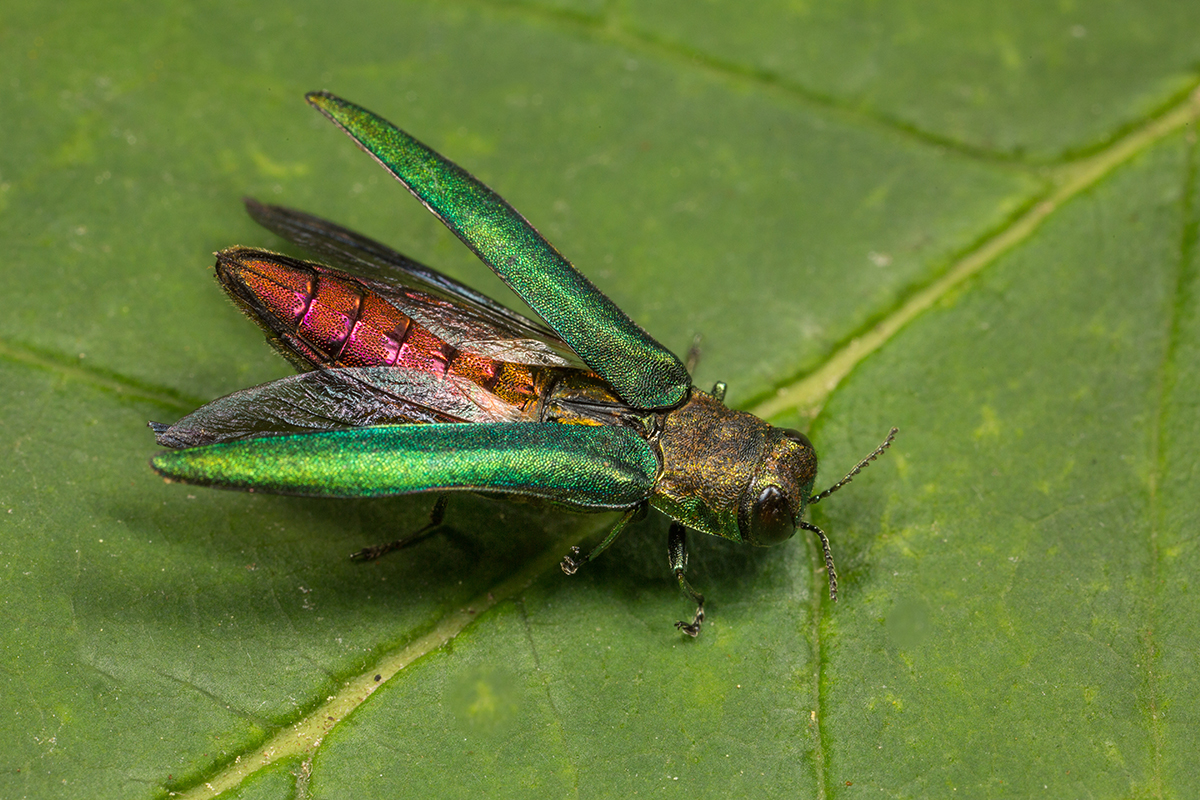Emerald Ash Borer (Agrilus planipennis)

Key Identification Features
Adult Insects
Bright metallic green carapace
Dorsal surface usually a bright red
Elongated & flattened body
Infested Ash Trees
Small, D-shaped exit holes in Ash trees
Bark flecking and cracking in the upper branches of tree
Dropping of large branches
often shatter upon impact
Description
The effects of Emerald Ash Borers (EAB) are more commonly observed than the insects themselves, however, larvae, pupae, and adults can be found upon closer inspection. Ash trees infested with EAB often begin to drop large branches without notice that shatter when they hit the ground. Their bark begins to fleck and crack and when peeled away tunnels bored into the wood are apparent. When emerging EAB leave small, D-shaped holes in the wood. Leaves will begin to die back and discolor as EAB kill their host tree.
The larvae are larger than the adults, between 25-32mm in length when fully grown. They tend to be cream-colored with broad, flattened brown heads. Larvae have a 10-segmented abdomen and a fork-like appendage on the tip of the abdomen.
Pupae are between 10-15mm long and a creamy white color. As they mature they begin taking on the emerald colors of the adults. Once mature, they bore out of the wood leaving small D-shaped exit holes.
Adult EAB are bright, metallic green insects with elongated, flattened bodies. The underside of the elytra is typically bright red. Adults are between 8-14mm long and ~3mm wide. Adults feed on the leaves of their host trees through much of their lives and deposit their eggs between bark crevices or cracks in late June to early July.
Native Range
EAB are native to Asia and were likely first brought to North America in wooden packing material. EAB was first identified in SE Michigan in 2002 and is now found throughout much of the Eastern U.S. and Canada.
Habitat and Dispersion
EAB parasitizes native Ash trees (Fraxinus spp.) often resulting in the tree’s death within 2-4 years. Adults are capable of traveling 15km but their spread has been greatly aided by the movement of infected wood and trees.
Best Management Practices
EAB has become widely established in North America and eradication is unlikely at this point. Avoid moving wood out of infected areas and practice Buy it Where you Burn it. Infested trees can be cut down and burnt with caution, infested trees are fragile and can drop large branches without warning. Some studies using parasitic wasps are showing promise as biological control, but more research is needed.
Aquatic Plants
Floating Plants
Submerged
Aquatic Animals
Molluscs
Crustaceans
Terrestrial Plants
Trees
Shrubs
Terrestrial Animals
Forest Pests
Vertebrates
We Need Your Help!
Have you spotted emerald ash borer in the CRISP PRISM? We want to know.
Report Now
